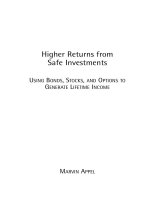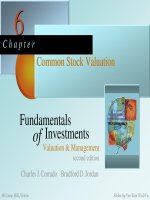Charles J. Corrado_Fundamentals of Investments - Chapter 12 pdf
Bạn đang xem bản rút gọn của tài liệu. Xem và tải ngay bản đầy đủ của tài liệu tại đây (676.67 KB, 55 trang )
CHAPTER 12
Government Bonds
U.S. Treasury bonds are among the safest investments available because
they are secured by the considerable taxing powers of the federal
government. Many bonds issued by federal government agencies, and by
state and local municipal governments are also nearly free of default risk.
Consequently, government bonds are generally excellent vehicles for
conservative investment strategies seeking predictable investment results.
The largest and most important debt market is that for debt issued by the federal government
of the United States. This market is truly global in character since a large share of federal debt is sold
to foreign investors, and it thereby sets the tone for debt markets around the world. In contrast, the
market for debt issued by states and municipalities is almost exclusively a domestic market since
almost all U.S. municipal securities are owned by U.S. investors. These two broad categories make
up the government bond market. In this chapter, we examine securities issued by federal, state, and
local governments, which combined represent more than $7 trillion of outstanding securities.
12.1 Government Bond Basics
The U.S. federal government is the largest single borrower in the world. In 1999 the gross
public debt of the U.S. government was more than $5 trillion. Part of this debt is financed internally,
but the bulk is financed by the sale of a wide array of debt securities to the general public.
Responsibility for managing outstanding government debt belongs to the U.S. Treasury, which acts
as the financial agent of the federal government.
2 Chapter 12
The U.S. Treasury finances government debt by issuing marketable securities and
nonmarketable securities. Most of the gross public debt is financed by the sale of marketable
securities at regularly scheduled Treasury auctions. Marketable securities include Treasury bills,
Treasury notes, and Treasury bonds, often simply called T-bills, T-notes, and T-bonds, respectively.
Outstanding marketable securities trade among investors in a large, active financial market called the
Treasury market. Nonmarketable securities include U.S. Savings Bonds, Government Account Series,
and State and Local Government Series. Many individuals are familiar with U.S. Savings Bonds since
they are sold only to individual investors. Government Account Series are issued to federal
government agencies and trust funds, in particular, the Social Security Administration trust fund.
State and Local Government Series are purchased by municipal governments.
Treasury security ownership is registered with the U.S. Treasury. When an investor sells a
U.S. Treasury security to another investor, registered ownership is officially transferred by notifying
the U.S. Treasury of the transaction. However, only marketable securities allow registered ownership
to be transferred. Nonmarketable securities do not allow a change of registered ownership and
therefore cannot trade among investors. For example, a U.S. Savings Bond is a nonmarketable
security. If an investor wishes to sell a U.S. Savings Bond, it must be redeemed by the U.S. Treasury.
This is normally a simple procedure, since most banks handle the purchase and sale of U.S. Savings
Bonds for their customers.
Another large market for government debt is the market for municipal government debt.
There are more than 80,000 state and local governments in the United States, almost all of which
have some form of outstanding debt. In a typical year, well over 10,000 new municipal debt issues
are brought to market. Total municipal debt outstanding in the United States is about $2 trillion. Of
Government Bonds 3
this total, individual investors hold about half, either through direct purchase or indirectly through
mutual funds. The remainder is split about equally between holdings of property and casualty
insurance companies and commercial banks.
(marg. def. face value The value of a bill, note, or bond at its maturity when a
payment of principal is made. Also called redemption value.)
(marg. def. discount basis Method of selling a Treasury bill at a discount from face
value.)
(marg. def. imputed interest The interest paid on a Treasury bill determined by the
size of its discount from face value.)
12.2 U.S. Treasury Bills, Notes, Bonds, and STRIPS
Treasury bills are short-term obligations that mature in one year or less. They are originally
issued with maturities of 13, 26, or 52 weeks. A T-bill entitles its owner to receive a single payment
at the bill's maturity, called the bill's face value or redemption value. The smallest denomination T-bill
has a face value of $1,000. T-bills are sold on a discount basis, where a price is set at a discount
from face value. For example, if a $10,000 bill is sold for $9,500, then it is sold at a discount of $500,
or 5 percentt. The discount represents the imputed interest on the bill.
Treasury notes are medium-term obligations with original maturities of 10 years or less, but
more than 1 year. They are normally issued with original maturities of 2, 5, or 10 years, and have face
value denominations as small as $1,000. Besides a payment of face value at maturity, T-notes also
pay semiannual coupons.
Treasury bonds are long-term obligations with much longer original-issue maturities. Since
1985, the Treasury has only issued T-bonds with a maturity of 30 years in its regular bond offerings.
4 Chapter 12
Like T-notes, T-bonds pay their face value at maturity, pay semi-annual coupons, and have face value
denominations as small as $1,000.
The coupon rate for T-notes and T-bonds is set according to interest rates prevailing at the
time of issuance. For example, if the prevailing interest rate for a Treasury note of a certain maturity
is 5 percent, then the coupon rate - that is, the annual coupon as a percent of par value - for a new
issue with that maturity is set at or near 5 percent. Thus a $10,000 par value T-note paying a
5 percent coupon would pay two $250 coupons each year. Coupon payments normally begin six
months after issuance and continue to be paid every six months until the last coupon is paid along
with the face value at maturity. Once set, the coupon rate remains constant throughout the life of a
U.S. Treasury note or bond.
(marg. def. STRIPS Treasury program allowing investors to buy individual coupon
and principal payments from a whole Treasury note or bond. Acronym for Separate
Trading of Registered Interest and Principal of Securities )
Treasury STRIPS are derived from Treasury notes originally issued with maturities of 10
years, and from Treasury bonds issued with 30-year maturities. Since 1985, the U.S. Treasury has
sponsored the STRIPS program, an acronym for Separate Trading of Registered Interest and
Principal of Securities. This program allows dealers to divide Treasury bonds and notes into coupon
strips and principal strips, thereby allowing investors to buy and sell the strips of their choice.
Principal strips represent face-value payments and coupon strips represent coupon payments. For
example, a 30-year maturity T-bond can be separated into 61 strips, representing 60 semiannual
coupon payments and a single face value payment. Under the Treasury STRIPS program, each of
these strips can be separately registered to different owners.
Government Bonds 5
Investment Updates. Zero-coupon bonds
The terms “STRIPS” and “strips” can sometimes cause confusion. The acronym STRIPS is
used when speaking specifically about the Treasury STRIPS program. However, the term strips now
popularly refers to any separate part of a note or bond issue broken down into its component parts.
In this generic form, the term strips is acceptable.
(marg. def. zero coupon bonds A note or bond paying a single cash flow at maturity.
Also called zeroes.)
Since each strip created under the STRIPS program represents a single future payment,
STRIPS securities effectively become zero coupon bonds and are commonly called zeroes. The
unique characteristics of Treasury zeroes makes them an interesting investment choice. The potential
benefits of STRIPS in an investor’s portfolio are discussed in the Wall Street Journal article reprinted
in the nearby Investment Updates box.
CHECK THIS
12.2a What are some possible reasons why individual investors might prefer to buy Treasury
STRIPS rather than common stocks?
12.2b What are some possible reasons why individual investors might prefer to buy individual
Treasury STRIPS rather than whole T-notes or T-bonds?
The yield to maturity of a zero coupon bond is the interest rate that an investor will receive
if the bond is held until it matures. Table 12.1 lists bond prices for zero coupon bonds with face value
of $10,000, maturities of 5, 10, 20, and 30 years, and yields from 3 percent to 15 percent. As shown,
6 Chapter 12
Table 12.1 about here.
Figure 12.1 about here.
Figure 12.2 about here.
a $10,000 face-value zero coupon bond with a term to maturity of 20 years and an 8 percent yield
has a price of $2,082.89.
Figure 12.1 graphs prices of zero coupon bonds with a face value of $10,000. The vertical
axis measures bond prices and the horizontal axis measures bond maturities. Bond prices for yields
of 4, 8, and 12 percent are illustrated.
CHECK THIS
12.2c For zero coupon bonds with the same face value and yield to maturity, is the price of a zero
with a 15-year maturity larger or smaller than the average price of two zeroes with maturities
of 10 years and 20 years? Why?
Treasury Bond and Note Prices
Figure 12.2 displays a partial Wall Street Journal listing of prices and other relevant
information for Treasury securities. Notice that Treasury notes and bonds are listed together, but
there are separate sections for Treasury bills and Treasury STRIPS. The sections for Treasury bills
and STRIPS were discussed in detail in Chapter 9. We discuss the section for Treasury notes and
bonds next.
Government Bonds 7
Treasury bond and note price quotes are stated on a percentage of par basis where, for
example, a price of 102 equals par value plus 2 percent. Fractions of a percent are stated in thirty-
seconds. Thus a price stated as 102:28 is actually equal to 102 + 28/32, or 102.875. To illustrate, the
first column in the section for notes and bonds in Figure 12.2 states the annual coupon rate. The next
two columns report maturity in month-year format. Dealer bid and asked price quotes come next,
followed by changes in ask quotes from the previous day. The last column gives the yield to maturity
implied by an asked price quote. The letter n next to various maturity dates indicates a T-note. The
absence of the letter n indicates a T-bond
The quoted maturities for certain T-bonds have two years listed. For example, look at the
bond issue with a maturity listed as Nov 09-14. This means that the bond matures in November 2014,
but it is callable at par value any time after November 2009. When a T-bond is called, bondholders
surrender their bonds to receive a cash payment equal to the bond's par value. Because the Nov 09-14
bond pays an 11.75 percent coupon but has a much lower yield to maturity, this bond has a price well
above par value. It is likely that this bond will be called at its earliest possible call date in November
2009. Therefore, the reported asked yield is actually a yield to call. A yield to call (YTC) is the
interest rate for a bond assuming the bond will be called at its earliest possible call date and the bond
holder will hold the bond until it is called. When a callable T-bond has a price above par, the reported
yield is a yield to call.
(marg. def. yield to call (YTC) The interest rate on a bond that assumes the bond
will be called at its earliest possible call date.)
8 Chapter 12
Bond price
Annual coupon
YTM
×
1
1
(1 YTM/2)
2 M
Face value
(1 YTM/2)
2 M
Figure 12.3 about here.
Since 1985, the Treasury has issued only noncallable bonds. Thus the cluster of callable bonds
in Figure 12.2 were all issued before 1985, and all listed bonds with a maturity of 2015 or later are
noncallable bonds issued in 1985 or later.
Since Treasury bonds and notes pay semiannual coupons, bond yields are stated on a
semiannual basis. The relationship between the price of a note or bond and its yield to maturity was
discussed in Chapter 10. For convenience, the bond price formula from that chapter is restated here:
Figure 12.3 illustrates the relationship between the price of a bond and its yield to maturity
for 2-year, 7-year, and 30-year terms to maturity. Notice that each bond has a price of 100 when its
yield is 8 percent. This indicates that each bond has an 8 percent coupon rate, because when a bond’s
coupon rate is equal to its yield to maturity, its price is equal to its par value.
(marg. def. bid-ask spread The difference between a dealer’s ask price and bid
price.)
The difference between a dealer's asked and bid prices is called the bid-ask spread. The bid-
ask spread measures the dealer's gross profit from a single round-trip transaction of buying a security
at the bid price and then selling it at the asked price.
Government Bonds 9
CHECK THIS
12.2d What would Figure 12.3 look like if the three bonds all had coupon rates of 6 percent or had
coupon rates of 10 percent?
12.2e In Figure 12.2, which Treasury issues have the narrowest spreads? Why do you think this is
so?
12.2f Examine the spreads between bid and asked prices for Treasury notes and bonds listed in a
recent Wall Street Journal.
Table 12.2 General Auction Pattern for U.S. Treasury Securities
Security
Purchase
Minimum
Purchase in
Multiples of
General Auction
Schedule
13-Week Bill $1,000 $1,000 Weekly
26-Week Bill $1,000 $1,000 Weekly
52-Week Bill $1,000 $1,000 Every 4 Weeks
2-Year Note $1,000 $1,000 Monthly
5-Year Note $1,000 $1,000 February, May,
August, November
10-Year Note $1,000 $1,000
30-Year Bond $1,000 $1,000 February, August,
November
Inflation-Indexed Treasury Securities
In recent years, the U.S. Treasury has issued securities that guarantee a fixed rate of return
in excess of realized inflation rates. These inflation-indexed Treasury securities pay a fixed coupon
rate on their current principal, and adjust their principal semiannually according to the most recent
inflation rate.
10 Chapter 12
For example, suppose an inflation-indexed note is issued with a coupon rate of 3.5 percent
and an initial principal of $1,000. Six months later, the note will pay a coupon of
$1,000 × 3.5% / 2 = $17.50. Assuming 2 percent inflation over the six months since issuance, the
note’s principal is then increased to $1,000 × 102% = $1,020. Six months later, the note pays
$1,020 × 3.5% / 2 = $18.20 and its principal is again adjusted to compensate for recent inflation.
Price and yield information for inflation-indexed Treasury securities is reported in the Wall
Street Journal in the same section with other Treasury securities, as shown in Figure 12.2 Locating
the listing for inflation-indexed Treasury securities in Figure 12.2, we see that the first and second
columns report the fixed coupon rate and maturity, respectively. The third and fourth columns report
current bid/ask prices and the price change from the previous trading day. Prices for inflation-indexed
securities are reported as a percentage of current accrued principal. The fifth and sixth columns list
an inflation-adjusted yield to maturity and current accrued principal reflecting all cumulative inflation
adjustments.
12.3 U.S. Treasury Auctions
The Federal Reserve Bank conducts regularly scheduled auctions for Treasury bills, notes,
and bonds. Specifically, 13- and 26-week bills are auctioned on a weekly basis and 52-week bills are
auctioned every four weeks. Two-year notes are auctioned monthly; longer maturity notes are
auctioned each quarter. Bonds are sold three times per year. A statement regarding the face value
quantity of bills, notes, or bonds to be offered is announced before each auction. Table 12.2
summarizes the auction schedule and purchase conditions for U.S. Treasury securities. However,
from time to time the Treasury may change this schedule slightly.
Government Bonds 11
At each Treasury auction, the Federal Reserve accepts sealed bids of two types: competitive
bids and noncompetitive bids. Competitive bids for T-bills specify a bid price and a bid quantity. The
bid price is what the bidder is willing to pay and the bid quantity is the face value amount that the
bidder will purchase if the bid is accepted. Noncompetitive bids specify a only bid quantity since the
price charged to noncompetitive bidders will be determined by the results of the competitive auction
process. Individual investors can submit noncompetitive bids, but only Treasury securities dealers can
submit competitive bids.
(marg. def. stop-out bid The lowest competitive bid in a U.S. Treasury auction that
is accepted.)
At the close of bidding, all sealed bids are forwarded to the U.S. Treasury for processing. As
a first step, all noncompetitive bids are accepted automatically and are subtracted from the total issue
amount. Then a stop-out bid is determined; this is the price at which all competitive bids are
sufficient to finance the remaining issue amount. Competitive bids at or above the stop-out bid are
accepted and bids below the stop-out bid are rejected.
Since 1998, all U.S. Treasury auctions have been single-price auctions in which all accepted
competitive bids pay the stop-out bid. The stop-out bid is also the price paid by noncompetitive
bidders. For example, suppose an auction for T-bills with $20 billion of face value receives $28 billion
of competitive bids and $4 billion of noncompetitive bids. Noncompetitive bids are automatically
accepted, leaving $16 billion for competitive bidders. Now suppose the stop-out bid for this $16
billion amount is $9,700 for a $10,000 face value T-bill. Accepted competitive bidders and all
noncompetitive bidders pay this price of $9,700.
12 Chapter 12
The process is similar for T-bond and T-note issues, except that bids are made on a yield basis
where competitive bids state yields instead of prices. A coupon rate for the entire issue is then set
according to the average competitive-bid yield.
CHECK THIS
12.3a The Federal Reserve announces an offering of Treasury bills with a face value amount of $25
billion. The response is $5 billion of noncompetitive bids along with the following competitive
bids:
Bidder Price bid Quantity bid
A $9,500 $5 bil.
B $9,550 $5 bil.
C $9,600 $5 bil.
D $9,650 $5 bil.
E $9,700 $5 bil.
In a single-price auction, which bids are accepted and what prices are paid by each bidder?
How much money is raised by the entire offering?
12.4 U.S. Savings Bonds
The U.S. Treasury offers an interesting investment opportunity for individual investors in the
form of savings bonds. Two types of savings bonds are currently available, Series EE and Series I.
Other types exist, but they are either no longer available or can be obtained only by converting one
type for another. For more information, you should consult the official U.S. Savings Bonds website
(www.savingsbonds.gov), or the Bureau of Public Debt website (www.publicdebt.treas.gov).
Government Bonds 13
Series EE Savings Bonds
Series EE bonds are available in face value denominations ranging from $50 to $10,000, but
the original price of a Series EE bond is always set at exactly half its face value. Thus, Series EE
bonds are sold to resemble zero coupon securities. However, individuals purchasing Series EE bonds
receive semiannual interest accruals. Each May 1 and November 1, the Treasury sets the interest rate
on EE bonds at 90 percent of the yield on newly issued five-year maturity T-notes. For example,
suppose the yield on newly issued five-year maturity T-notes is 5.56 percent. In this case, the
Treasury will set an interest rate of .90 × 5.56% = 5.0% on savings bonds for the next six months.
This interest is paid as an accrual to the redemption value of the bond, where the current redemption
value is the original price of the bond plus all prior accrued interest.
Series I Savings Bonds
Series I bonds are also available in face value denominations ranging from $50 to $10,000,
but they are originally sold at face value. Each May 1 and November 1, the Treasury sets the interest
rate on Series I bonds at a fixed rate plus the recent inflation rate. In this way, Series I bonds are
indexed to inflation. For example, suppose the fixed rate is 3 percent, and the recent inflation rate is
2 percent. In this case, the Treasury will set an interest rate of 3% + 2% = 5% for the next six
months. This interest is paid as an accrual to the redemption value of the bond.
Savings bonds offer several tax advantages to individual investors. First, as with all
U.S. Treasury securities, savings bonds are not subject to state or local taxes. Also, federal income
tax payment on U.S. Savings Bond interest is deferred until the bonds are redeemed. With all factors
14 Chapter 12
considered, their overall attractiveness has led individual investors to hold almost $200 billion of U.S.
Savings Bonds.
CHECK THIS
12.4a Compare the methods by which interest is paid for Series I savings bonds and inflation-
indexed Treasury securities.
12.5 Federal Government Agency Securities
Most U.S. government agencies consolidate their borrowing through the Federal Financing
Bank, which obtains funds directly from the U.S. Treasury. However, several federal agencies are
authorized to issue securities directly to the public. For example, the Resolution Trust Funding
Corporation, the World Bank, and the Tennessee Valley Authority issue notes and bonds directly to
investors. Bonds issued by U.S. government agencies share an almost equal credit quality with U.S.
Treasury issues. Although most agency debt does not carry an explicit guarantee of the U.S.
Government, a federal agency on the verge of default would probably receive government support
to ensure timely payment of interest and principal on outstanding debt. This perception is supported
by historical experience and the political reality that Congress would likely feel compelled to rescue
an agency that it created if it became financially distressed.
What makes government agency notes and bonds attractive to many investors is that they
offer higher yields than comparable U.S. Treasury securities. However, the market for agency debt
is less active than the market for U.S. Treasury debt, and therefore the spread between dealers’ bid
and asked prices is greater for agency issues than for Treasury issues. For example, Figure 12.4
Government Bonds 15
Figure 12.4 about here.
presents dealer price quotes for agency issues as reported in the Wall Street Journal. The listing
format is the same as for Treasury notes and bonds described previously, except that callable bonds
are indicated by an asterisk with only the maturity date shown.
If you compare bid and asked dealer price quotes for agency bonds listed in Figure 12.4 with
similar Treasury bonds listed in Figure 12.2, you will find that agency bonds have a higher bid-asked
spread than Treasury bonds. The reason for the higher bid-ask spread is that agency bond trading
volume is much lower than Treasury bond trading volume. To compensate for the lower volume,
dealers charge higher spreads. Thus trading agency bonds is more costly than trading Treasury bonds.
Consequently, agency bonds are usually purchased by institutional investors planning to hold the
bonds until they mature. Another reason for the higher yields on agency bonds compared to Treasury
bonds is that interest income from agency bonds is subject to state and local taxation, whereas
Treasury interest payments are subject only to Federal taxation.
To illustrate, we consider a specific bond issue from the Tennessee Valley Authority (TVA).
The TVA is a federally-owned utility company operating in, you guessed it, the Tennessee River
Valley. In 1992, the TVA sold a $1 billion issue of 50-year maturity bonds in a public offering. This
was the first time in several decades that a U.S. government-affiliated issuer sold bonds with a 50-
year term to maturity. Pension funds and insurance companies purchased most of the bonds to match
the 8.25 percent coupons with future contractual payments to retirees and insurance beneficiaries.
The TVA offering included $500 million of stripped coupon bonds and $500 million of bonds
without a strips feature. The issue matures in 2042 but is callable after 20 years at a call price of 106.
16 Chapter 12
The call price is the amount bondholders will receive when the bond is called. “Nonstrippable” bonds
were sold with a yield to maturity of 8.515 percent, or .58 percent more than the yield on then current
30-year maturity Treasury bonds. The principal strips were sold to yield 8.94 percent, and yields on
coupon strips varied according to their payment dates.
The generous call price of 106 implies that if the bonds are called at the earliest possible call
date in 2012, their yield will be more than the originally stated yield to maturity. To evaluate a
potential early call, bond investors often refer to a bond's yield to call. As discussed in Chapter 10,
a bond's yield to call is the interest rate for a bond assuming that the bond is called at the earliest
possible call date. The TVA bonds originally sold at an average price of about 96:30, or $96.9375,
with a yield to call of 8.69 percent, or .175 percent more than the yield to maturity of 8.515 percent.
CHECK THIS
12.5a In Figure 12.4, find the price quotes for the Tennessee Valley Authority bond issue discussed
immediately above maturing in 2042.
12.5b From a recent issue of the Wall Street Journal, find the price quotes for the Tennessee Valley
Authority bond issue discussed immediately above. What is the spread between their bid and
asked prices?
12.5c Examine spreads between bid and asked prices for government agency notes and bonds listed
in a recent Wall Street Journal. What is the typical bid-asked spread?
Government Bonds 17
12.5 Municipal Bonds
Municipal notes and bonds are intermediate- to long-term interest-bearing obligations of state
and local governments or agencies of those governments. The defining characteristic of municipal
notes and bonds, often called “munis,” is that coupon interest is usually exempt from federal income
tax. Consequently, the market for municipal debt is commonly called the tax-exempt market. Most
of the 50 states also have an income tax, but their tax treatment of municipal debt interest varies. Only
a few states exempt coupon interest on out-of-state municipal bonds from in-state income tax, but
most states do allow in-state municipal debt interest an exemption from in-state income tax. In any
case, state income tax rates are normally much lower than federal income tax rates, and state taxes
can be used as an itemized deduction from federal taxable income. Consequently, state taxes are
usually a secondary consideration for municipal bond investors.
The federal income tax exemption makes municipal bonds attractive to investors in the highest
income tax brackets. This includes many individual investors, commercial banks, and property and
casualty insurance companies — precisely those investors who actually hold almost all municipal debt.
However, yields on municipal debt are less than on corporate debt with similar features and credit
quality. This eliminates much, but not all, of the advantage of the tax exemption. Therefore, tax-
exempt investors, including pension funds and retirement accounts of individuals, nonprofit
institutions, and some life insurance companies, normally do not invest in municipal bonds. Instead,
they prefer to invest in higher-yielding corporate bonds.
(marg. def. default risk The risk that a bond issuer will cease making scheduled
payments of coupons or principal or both.)
18 Chapter 12
Table 12.3 about here.
Municipal bonds are typically less complicated investments than corporate bonds. However,
while municipal debt often carries a high credit rating, default risk does exist. Thus, investing in
municipal debt requires more care than investing in U.S. Treasury securities.
To illustrate some standard features of a municipal bond issue, Table 12.3 a summarizes the
issue terms for a hypothetical bond issue by the city of Bedford Falls. We see that the bonds were
issued in December 1999 and mature 30 years later in December 2029. Each bond has a face value
denomination of $5,000 and pays an annual coupon equal to 6 percent of face value. The annual
coupon is split between two semiannual payments each June and December. Based on the original
offer price of 100, or 100 percent of par value, the bonds have a yield to maturity of 6 percent.
Bedford Falls bonds are call-protected for 10 years, until January 2009. Thereafter, the bonds are
callable any time at par value.
. (marg. def. general obligation bonds (GOs) Bonds issued by a municipality that are
secured by the full faith and credit of the issuer.)
The Bedford Falls bonds are general obligation bonds (GOs), which means that the bonds
are secured by the full faith and credit of the city of Bedford Falls. "Full faith and credit" means the
power of the municipality to collect taxes. The trustee for the bond issue is the Potters Bank of
Bedford Falls. A trustee is appointed to represent the financial interests of bondholders and administer
the sinking fund for the bond issue. A sinking fund requires a bond issuer to redeem for cash a
fraction of an outstanding bond issue on a periodic basis. The sinking fund in this example requires
that beginning 10 years after issuance, the city must redeem at par value $2.5 million of the bond issue
Government Bonds 19
$250
.0625
×
1
1
(1.03125)
14
$5,000
(1.03125)
14
$4,649.99
Figure 12.5 about here.
each year. At each annual redemption, a fraction of the bond issue is called and the affected
bondholders receive the par value call price.
Municipal Bond Features
Municipal bonds are typically callable, pay semiannual coupons, and have a par value
denomination of $5,000. Municipal bond prices are stated as a percentage of par value. Thus a price
of 102 indicates that a bond with a par value of $5,000 has a price of $5,100. By convention,
however, municipal bond dealers commonly use yield quotes rather than price quotes in their trading
procedures. For example, a dealer might quote a bid-yield of 6.25 percent for a 5 percent coupon
bond with seven years to maturity, indicating a willingness to buy at a price determined by that yield.
The actual dollar bid price in this example is $4,496.14, as shown in the following bond price
calculation.
Because there are many thousands of different municipal bond issues outstanding, only a few
large issues trade with sufficient frequency to justify having their prices reported in the financial press.
A Wall Street Journal listing of some actively traded municipal bonds is seen in Figure 12.5. The
listing reports the name of the issuer, the coupon rate and maturity of the issue, the most recent bid
price quote and the change from an earlier price quote, and a yield to maturity based on a dealer's bid
yield.
20 Chapter 12
(marg. def. call provision A feature of a municipal bond issue that specifies when the
bonds may be called by the issuer and the call price that must be paid.)
A call provision is a standard feature of most municipal bond issues. A call provision allows
an issuer to retire outstanding bonds before they mature, usually to refund with new bonds after a fall
in market interest rates. When the bond is called, each bondholder receives the bond's call price in
exchange for the bond. However, two bond features often limit an issuer's call privilege. First, callable
municipal bonds usually offer a period of call protection following their original issue date. Since a
bond issue is not callable during this period, the earliest possible call date is the end of the call
protection period. Second, a call price is often specified with a call premium. A call premium is the
difference between a bond's call price and its par value. A common arrangement is to specify a call
premium equal to one year's coupons for a call occurring at the earliest possible call date. This is then
followed by a schedule of call premium reductions, until about 5 to 10 years before maturity when
the call premium is eliminated entirely. Thereafter, the bond issue is callable any time at par value.
(marg. def. serial bonds Bonds issued with maturity dates scheduled at intervals, so
that a fraction of the bond issue matures in each year of a multiple-year period.)
Municipal bonds are commonly issued with a serial maturity structure, hence the term serial
bonds. In a serial bond issue, a fraction of the total issue amount is scheduled to mature in each year
over a multiple-year period. As an example, a serial bond issue may contain bonds that mature in each
year over a 5-year period, with the first group maturing 11 years after the original issue date, and the
last group maturing 15 years after issuance. The purpose of a serial maturity structure is to spread
out the principal repayment, thereby avoiding a lump-sum repayment at a single maturity date.
(marg. def. term bonds Bonds from an issue with a single maturity date.)
Government Bonds 21
When an entire bond issue matures on a single date, the bonds are called term bonds. Term
bonds normally have a sinking fund provision. A sinking fund is a trustee-managed account to which
the issuer makes regular payments. Account reserves are dedicated toward redeeming a fraction of
the bond issue on each of a series of scheduled redemption dates. Each redemption usually proceeds
by lottery, where randomly selected bonds are called and the affected bondholders receive the sinking
fund call price. Alternatively, scheduled redemptions can be implemented by purchasing bonds from
investors at current market prices. This latter option is usually selected by the issuer when the bonds
are selling at a discount from par value. The motive for a sinking fund provision is similar to that for
a serial maturity structure; it provides a means for the issuer to avoid a lump-sum principal repayment
at a single maturity date.
(marg. def. put bonds Bonds that can be sold back to the issuer.)
Some municipal bonds are putable, and these are called put bonds. The holder of a put bond,
also called a tender offer bond, has the option of selling the bond back to the issuer, normally at par
value. Some put bonds can be tendered any time, wheras others can be tendered only on regularly
scheduled dates. Weekly, monthly, quarterly, semiannual, and annual put date schedules are all used.
Notice that with a put bond, maturity is effectively the choice of the bondholder. This feature protects
bondholders from rising interest rates and the associated fall in bond prices. However, a putable bond
will have a higher price than a comparable nonputable bond. The price differential simply reflects the
value of the put option to sell back the bonds.
(marg. def. variable-rate notes Securities that pay an interest rate that changes
according to market conditions. Also called floaters.)
22 Chapter 12
Investment Updates box.
While most municipal bonds maintain a constant coupon rate (hence the term fixed-rate
bonds), interest rate risk has induced many municipalities to issue variable-rate notes, often called
floaters. For these debt issues, the coupon rate is adjusted periodically according to an index-based
rule. For example, at each adjustment the coupon rate may be set at 60 percent of the prevailing rate
on 91-day maturity U.S. Treasury bills. A variable-rate note may also be putable, in which case it is
called a variable-rate demand obligation, often abbreviated to VRDO. A stipulation attached to most
VRDOs allows the issuer to convert an entire variable-rate issue to a fixed-rate issue following a
specified conversion procedure. Essentially, the issuer notifies each VRDO holder of the intent to
convert the outstanding VRDO issue to a fixed-rate issue on a specific future date. In response,
VRDO holders have the option of tendering their VRDOs for cash, or they can accept conversion of
their VRDOs into fixed-rate bonds. In the late 1980s, following a decade of volatile interest rates,
VRDOs made up about 10 percent of the total value of outstanding municipal bonds.
For the first time in 1993, several municipalities issued bonds with strippable coupons and
principal, called muni-strips. Like the U.S. Treasury STRIPS program, muni-strips allow separate
trading of registered interest and principal. The Wall Street Journal story of an issue of muni-strips
offered by the government of Puerto Rico appears in the nearby Investment Updates box. Puerto Rico
is a protectorate of the United States and bonds issued by the government of Puerto Rico are not
subject to taxation of coupon interest. Another part of the Puerto Rico bond offering is composed
of inverse floaters. Inverse floaters are like the variable- or floating-rate bonds discussed above.
However, inverse floaters pay a variable coupon rate that moves inversely with market interest rates.
Government Bonds 23
That is, higher interest is paid when market interest rates fall and lower interest is paid when market
interest rates rise.
Inverse floaters are created by splitting the interest payments of a bond issue with fixed
coupons. For example, suppose a municipality issues $10 million face value bonds paying fixed
6 percent coupons. The bonds are placed in a trust, and the fixed annual $600,000 coupons are used
to pay interest on floaters and inverse floaters that are issued as claims on the trust. Initially, the
interest payments may be split equally between the floaters and inverse floaters. Later, if market
interest rates increase, interest payments on the floaters will rise and interest payments on the inverse
floaters will fall. If market interest rates decrease, floater interest will fall and inverse floater interest
will rise. Total interest payments to floaters and inverse floaters will remain constant.
(marg. def. revenue bonds Municipal bonds secured by revenues collected from a
specific project or projects.)
Types of Municipal Bonds
There are two basic types of municipal bonds: revenue bonds and general obligation bonds,
often referred to as GOs. General obligation bonds are issued by all levels of municipal governments,
including states, counties, cities, towns, school districts, and water districts. They are secured by the
general taxing powers of the municipalities issuing the bonds. For state governments and large city
governments, tax revenue is collected from a diverse base of income taxes on corporations and
individuals, sales taxes, and property taxes. In contrast, tax revenues for smaller municipalities are
largely derived from property taxes, although sales taxes have become increasingly important.
24 Chapter 12
Because of their large, diverse tax bases, general obligation bonds issued by states and large cities are
often called unlimited tax bonds or full faith and credit bonds.
However, some general obligation bonds are called limited tax bonds. The distinction between
limited and unlimited tax bonds arises when a constitutional limit or other statutory limit is placed on
the power of a municipality to assess taxes. For example, an amendment to the California state
constitution, popularly known as Proposition 13 when it was enacted, placed rigid limits on the ability
of California municipalities to assess taxes on real estate.
Revenue bonds constitute the bulk of all outstanding municipal bonds. Revenue bonds are
bonds secured by proceeds collected from the projects they finance. Thus the credit quality of a
revenue bond issue is largely determined by the ability of a project to generate revenue. A few
examples of the many different kinds of projects financed by revenue bonds are listed below.
Airport and seaport bonds: Used to finance development of airport and seaport
facilities. Secured by user fees and lease revenues.
College dormitory bonds: Used to finance construction and renovation of
dormitory facilities. Secured by rental fees.
Industrial development bonds: Used to finance development of projects ranging from
factories to shopping centers. Secured by rental and
leasing fees.
Multifamily housing bonds: Used to finance construction of housing projects for
senior citizens or low-income families. Secured by
rental fees.
Highway and road gas tax bonds: Used to finance highway construction. May be secured
by specific toll revenues, or general gas tax revenues.
Student loan bonds: Used to purchase higher-education guaranteed student
loans. Secured by loan repayments and federal
guarantees.
Government Bonds 25
(marg. def. hybrid bonds Municipal bonds secured by project revenues with some
form of general obligation credit guarantees.)
Many municipal bonds possess aspects of both general obligation and revenue bonds; these
are called hybrid bonds. Typically, a hybrid is a revenue bond secured by project-specific cash flows,
but with additional credit guarantees. A common form of hybrid is the moral obligation bond. This
is a state-issued revenue bond with provisions for obtaining general revenues when project-specific
resources are inadequate. Usually, extra funds can be obtained only with approval of a state
legislature, which is said to be “morally obligated” to assist a financially distressed state-sponsored
project. However, a moral obligation is not a guarantee, and the likelihood of state assistance varies.
Municipal bond credit analysts consider each state's history of assistance as well as current state
financial conditions when evaluating the credit-quality enhancement of the moral obligation. In
general, experienced municipal bond investors agree that a state will first service its own general
obligation debt before providing service assistance to moral obligation debt. This is evidenced by the
typically higher yields on moral obligation debt compared to general obligation debt.
Since 1983, all newly issued municipal bonds have had to be registered - that is, with the
identity of all bondholders registered with the issuer. With registered bonds, the issuer sends coupon
interest and principal payments only to the registered owner of a bond. Additionally, it is now
standard practice for registered bonds to be issued in book entry form; bondholders are not issued
printed bond certificates but instead receive notification that their ownership is officially registered.
The actual registration record is maintained by the issuer in computer files. This contrasts with the
now defunct practice of issuing bearer bonds, where coupon interest and principal were paid to
anyone presenting the bond certificates.









